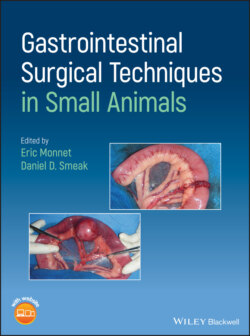Читать книгу Gastrointestinal Surgical Techniques in Small Animals - Группа авторов - Страница 101
References
Оглавление1 Adams, R.J. et al. (2014). Closed suction drainage for treatment of septic peritonitis of confirmed gastrointestinal origin in 20 dogs. Vet. Surg. 43 (7): 843–851.
2 Bonczynski, J.J. et al. (2003). Comparison of peritoneal fluid and peripheral blood pH, bicarbonate, glucose, and lactate concentration as a diagnostic tool for septic peritonitis in dogs and cats. Vet. Surg. 32 (2): 161–166.
3 Buote, N.J. and Havig, M.E. (2012). The use of vacuum‐assisted closure in the management of septic peritonitis in six dogs. J. Am. Anim. Hosp. Assoc. 48 (3): 164–171.
4 Cioffi, K.M. et al. (2012). Retrospective evaluation of vacuum‐assisted peritoneal drainage for the treatment of septic peritonitis in dogs and cats: 8 cases (2003–2010). J. Vet. Emerg. Crit. Care 22 (5): 601–609.
5 Davis, D.J. et al. (2018). Influence of preoperative septic peritonitis and anastomotic technique on the dehiscence of enterectomy sites in dogs: a retrospective review of 210 anastomoses. Vet. Surg. 47 (1): 125–129.
6 D'Hondt, M. et al. (2007). Systemic peritoneal cavity lavage: a new strategy for treatment of the open septic abdomen. Acta Chir. Belg. 107 (5): 583–587.
7 Diebel, L.N. et al. (1992). Effect of increased intra‐abdominal pressure on hepatic arterial, portal venous, and hepatic microcirculatory blood flow. J. Trauma 33 (2): 279–282; discussion 282–273.
8 Hondt, M. et al. (2011). Can vacuum‐assisted closure and instillation therapy (vac‐instill therapy) play a role in the treatment of the infected open abdomen? Tech. Coloproctol. 15 (1): 75–77.
9 Hosgood, G. (1990). The history of surgical drainage. J. Am. Vet. Med. Assoc. 196 (1): 42–44.
10 Hosgood, G. et al. (1989). Intraperitoneal circulation and drainage in the dog. Vet. Surg. 18 (4): 261–268.
11 Hosgood, G. et al. (1991). Open peritoneal drainage versus sump‐penrose drainage: Clinicopathological effects in normal dogs. J. Am. Anim. Assoc. 27: 115–121.
12 Ivatury, R.R. et al. (2001). Abdominal compartment syndrome: recognition and management. Adv. Surg. 35: 251–269.
13 Ludwig, L.L. et al. (1997). Surgical treatment of bile peritonitis in 24 dogs and 2 cats: a retrospective study (1987–1994). Vet. Surg. 26 (2): 90–98.
14 Madback, F.G. and Dangleben, D.A. (2015). Options in the Management of the Open Abdomen. New York: Springer.
15 Salisbury, S.K. and Hosgood, G.L. (1989). Management of the patient with generalized peritonitis. Problems in Vet. Med. 1 (2): 168–182.
16 Schein, M. (2002). Surgical management of intra‐abdominal infection: is there any evidence? Langenbecks Arch. Surg. 387 (1): 1–7.
17 Schein, M. et al. (1995). The abdominal compartment syndrome: the physiological and clinical consequences of elevated intra‐abdominal pressure. J. Am. Coll. Surg. 180 (6): 745–753.
18 Spillebeen, A.L. et al. (2017). Negative pressure therapy versus passive open abdominal drainage for the treatment of septic peritonitis in dogs: a randomized, prospective study. Vet. Surg. 46 (8): 1086–1097.
19 Staatz, A.J. et al. (2002). Open peritoneal drainage versus primary closure for the treatment of septic peritonitis in dogs and cats: 42 cases (1993–1999). Vet. Surg. 31 (2): 174–180.
20 Szabo, S.D. et al. (2011). Evaluation of postceliotomy peritoneal drain fluid volume, cytology, and blood‐to‐peritoneal fluid lactate and glucose differences in normal dogs. Vet. Surg. 40 (4): 444–449.
21 Way, L.I. and Monnet, E. (2014). Determination and validation of volume to be instilled for standardized intra‐abdominal pressure measurement in dogs. J. Vet. Emerg. Crit. Care 24 (4): 403–407.
